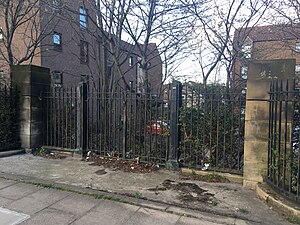History
Although originally intended to be built in 1913, its construction was delayed because of the First World War, and it was formally opened by King George V 10 years later in July 1923. [2] [3] Its electricity was used to power Edinburgh and the surrounding region while waste heat warmed the water of Portobello Open Air Pool. [1] At that time the turbine room contained three 12,500 kW turbines fed by six tri-drum water-tube boilers with integral superheaters and superposed economisers, each designed for a maximum continuous capacity of 80,000 lb. of steam per hour. In 1925 the plant was supplemented by a further 12,500 kW turbine. In 1927 two Brown Boveri 31,250MW turbines were added. These were accommodated in extensions to the 1923 building and also include eight more boilers. [4]
In 1938 the design of the station was extended by Edinburgh architect Ebenezer James MacRae; its six individual chimneys were replaced with a single 365 feet tall stack, [5] which weighed 10,000 tons, was made up of 710,000 bricks [6] and cost in the region of £118,000 to build. [1] [7]
Between 1952 and 1955, the power station achieved the highest thermal efficiency of any station in the UK, with peak output of around 279 megawatts, [8] although an explosion in February 1953 led to a two-hour power blackout across Edinburgh. The explosion, which could be heard a mile away, was caused by sea spray collecting on high-voltage insulators in the main-grid substation. [9]
The power station closed on 31 March 1977 [10] and demolished in 1980; a new housing estate was built on the site. [1] During demolition, the chimney had to be taken down brick by brick because of its proximity to nearby houses. [11]
The Portobello coat-of-arms on the power station was rescued during demolition and it was planned to incorporate it into a new sports centre to be built in the area. [12] This never happened and in 2016 the broken coat of arms was located in a City of Edinburgh Council storage facility in the west of Edinburgh. [13]
This page is based on this
Wikipedia article Text is available under the
CC BY-SA 4.0 license; additional terms may apply.
Images, videos and audio are available under their respective licenses.

